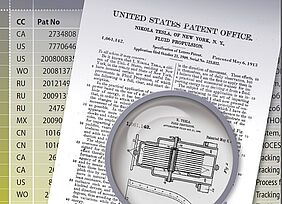Aenert news. Invention analysis
Earlier we have revised a number of topics related to enhanced oil recovery, such as those related to chemical stimulation (18.04.2022), gas injection or water flooding (09.05.2022), steam injection (06.08.2022), and provided some information on individual aspects of steam-assisted oil recovery – SAGD approach (06.12.2022) and Steam generators (10.02.2023). This time we will have a look at inventions that combine steam-assisted EOR technologies with chemical stimulation.
More than 2200 patent documents published over the past twenty years were selected for this patent analysis using the Advanced Energy Technologies methodology. Patents and patent applications have been published in 34 patent offices around the world by 544 applicants from 28 countries.
Unconventional oil. Steam and chemicals. Relationship of number of applications to total number of documents by year
According to the chart above, the registration of patent applications on the subject of interest peaked in 2014-2016, which led to an increase in the number of granted patents in 2018-2020. The peak was followed by a decline in the number of patent applications, which suggests that the number of patents in the nearest future will somewhat decrease. In 2017-2021 about 35%-55% of the technical solutions were represented by start patent applications, that didn’t belong to previously formed patent families.
In recent years, there was a peak of new IPC subgroups in 2014-2018 in the pool of documents related to the subject under consideration, while the number of newly appearing applicants was on an average level. At the same time, a number of new patent offices was very small after 2013. This can indicate that a substantial number of new inventors and companies are entering the market, proposing new and diversified technical solutions, but mainly in the established set of countries.
During the twenty-year period, the largest number of patents were issued in the USPTO (US) patent office – about 32% of the entire collection of patents. It was followed by CIPO (CA) with about 20% and CNIPA (CN) – around 18%. Rospatent (RU), IP Australia (AU), JPO (JP), and EPO should also be mentioned as the patent offices where a considerable number of patents were granted during the 20-year period. CNIPA (CN) and CIPO (CA) were leading by the number of patent applications registered in the past 5 years with shares of around 25% and 24%.
Unconventional oil. Steam and chemicals. Breakdown of inventions by patent offices. Patents, 2002-2021 (left); Applications, 2017-2021 (right)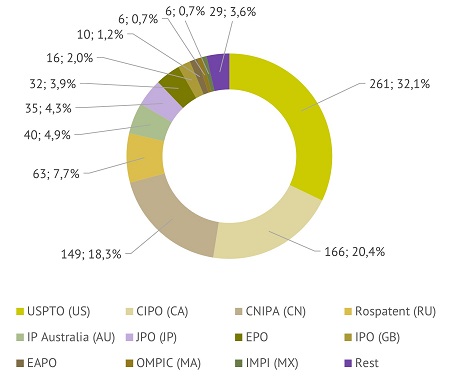
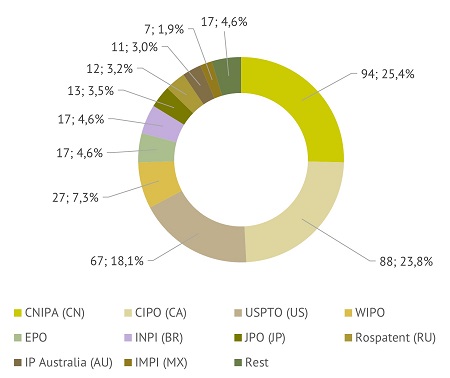
By the number of patents granted during the 20-year period, residents of the United States were in the lead with a share of almost 50% of all cases, followed by residents of Canada and China with about 17% and 11%, respectively. For patent applications published in the past five years, the leaders were the same – the United States, China, and Canada.
Below is a list of top 10 applicants for patents published in the 20-year period:
Unconventional oil. Steam and chemicals. Top applicants. Patents, 2002-2021
| Status | Country | Name | Average rating | Total 2002-2021 |
|---|---|---|---|---|
| Company | US | ExxonMobil Upstream Research Company | 18 | 130 |
| Company | US | Shell Oil Company | 18.1 | 84 |
| Company | NL | Shell Internationale Research Maatschappij B.V. | 18.1 | 72 |
| Company | US | General Electric | 18.1 | 52 |
| Company | US | Halliburton Energy Services, Inc. | 17.6 | 42 |
| Company | US | ConocoPhilips Company | 16.7 | 35 |
| Company | CA | Imperial Oil Resources Ltd. | 15.5 | 29 |
| Company | CN | Sinopec China Petroleum & Chemical Corporation | 14.8 | 24 |
| Company | CA | Suncor Energy | 17.5 | 24 |
| Company | DE | Siemens AG | 16.1 | 20 |
Of all applicants participating in the reviewed pool of documents, ExxonMobil Upstream Research Company (US) had the highest Market involvement ratio for patents published between 2002-2021 – about 12% (Market involvement ratio = volume ratio multiplied by ownership ratio, where Volume ratio - share of applicant documents in total number of documents, Ownership ratio - applicant's participation share in total number of documents). It was followed by Shell Oil Company (US) (more than 10%) and Shell Internationale Research Maatschappij B.V. (NL) (more than 9%). As for recent applications, the top three applicants in this respect were Dow Global Technologies, LLC (US) – more than 10%, ExxonMobil Upstream Research Company (US) – nearly 10%, and Wuhan Institute of Technology (CN) – about 5%.
Unconventional oil. Steam and chemicals. Top applicants. Applications, 2017-2021
| Status | Country | Name | Average rating | Total 2017-2021 |
|---|---|---|---|---|
| Company | US | ExxonMobil Upstream Research Company | 13 | 46 |
| Company | US | Dow Global Technologies, LLC | 10.4 | 40 |
| Company | CN | Sinopec China Petroleum & Chemical Corporation | 10.9 | 19 |
| Organization | CN | Wuhan Institute of Technology | 9 | 19 |
| Company | CA | Fluid Energy Group Ltd | 11 | 17 |
| Company | CA | Suncor Energy | 13.6 | 16 |
| Company | CA | Cenovus Energy, Inc. | 11.7 | 15 |
| Company | CN | PetroChina Company Limited | 11.3 | 15 |
| Company | US | General Electric | 13.5 | 13 |
| Company | CA | Alberta Ltd. | 8.9 | 11 |
In the collection of patent documents describing technologies of steam-assisted enhanced oil recovery with the use of chemicals, the most commonly mentioned problems were Low efficiency of primary production, Energy, gas or water consumption, and Environmental balance and protection. In the majority of cases, the authors of patents and patent applications disclosed their technical solutions in the forms of methods. Devices and compositions, although described in a substantial number of documents, are encountered less often. The most popular IPC subgroups assigned to the patent documents in the collection under revision are: E21B43/24 (using heat, e.g. steam injection); E21B43/22 (Use of chemicals or bacterial activity); E21B43/16 (Enhanced recovery methods for obtaining hydrocarbons); F02C3/34 (with recycling of part of the working fluid, i.e. semi-closed cycles with combustion products in the closed part of the cycle); and C09K8/592 (Compositions used in combination with generated heat, e.g. by steam injection).
In the revised pool of documents, the two largest patent families comprise 79 and 78 patent documents and are represented by core documents US8240774B2 and AU2008242810B2, respectively (Core document is a base document for which a complete description of the invention is available in generally-accessible patent databases). They are followed by a 35-document patent family with core document US10100741B2:
Solution mining and in situ treatment of nahcolite beds / P: US8240774B2 / IPC: E21B43/28 / Vinegar Harold J / Shell Oil Company / Appl. date: 13/10/2008; Publ. date: 14/08/2012 / United States Patent and Trademark Office / Core document: US8240774B2 / Technology categories: HO, OSH, OSN / Technology elements: RPIE, STI, STcs / Problems: EGWC, LEPP / Technical solution types: M / Claims: 20 / Rating: 18
Controlling and assessing pressure conditions during treatment of tar sands formations / P: AU2008242810B2 / IPC: E21B43/16 / Beer Gary Lee, Zhang Etuan / Shell Internationale Research Maatschappij B.V. / Appl. date: 18/04/2008; Publ. date: 02/02/2012 / IP Australia / Core document: AU2008242810B2 / Technology categories: OSN / Technology elements: GWF, RPIE, STI, STcs / Problems: LEPP / Technical solution types: D, M / Claims: 28 / Rating: 18
System and method for diffusion combustion with oxidant-diluent mixing in a stoichiometric exhaust gas recirculation gas turbine system / P: US10100741B2 / IPC: F02C7/22, F02C1/00, F02C1/08, F23C9/08, F23D14/58, F23R3/28, F02C3/34, F23K5/00, F23L7/00, F23C9/00, F23R3/40, F23D14/20, F23R3/34, F23D14/22, F02C3/30 / Huntington Richard A, Dhanuka Sulabh K, Slobodyanskiy Ilya Aleksandrovich / General Electric Company, ExxonMobil Upstream Research Company / Appl. date: 30/10/2013; Publ. date: 16/10/2018 / United States Patent and Trademark Office / Core document: US10100741B2 / Technology categories: UGT / Technology elements: GWF, STI, STcs, STs / Problems: EBP, UP / Technical solution types: D, M / Claims: 19 / Rating: 19
The following abbreviations are used in the documents hereinbefore and hereinafter: D - Device; M - Method; C - Composition; OSH - Oil shale; OSN - Oil sands; HO - Heavy and extra heavy oil; UGT - Unspecified or general technologies; DAW - Drilling and well elements; GWF - Gas injection or water flooding; RPIE - Reservoir permeability improvement and extraction; STcs - Steam injection & chemical stimulation; STem - Equipment and materials for drilling and steam injection; STgd - SAGD; STI - Steam injection; STs - Surface-generated steam; EBP - Environmental balance and protection; EGWC - Energy, gas or water consumption; HCEI - High capital costs of exploration and infrastructure; HCG - High capital or running costs in general; HCRR - High running costs of repair and replacement; HRCM - High running costs of maintenance; LEPP - Low efficiency of primary production; UP - Unclear problem.
Unconventional oil. Steam and chemicals. Breakdown of documents by family size. Patents and applications, 2002-2021
Below are some examples of technical solutions with the highest rating calculated using Advanced Energy Technologies methodology, from the pool of documents disclosing steam-assisted EOR technologies involving the use of chemicals:
Unconventional oil. Steam and chemicals. Prominent patent documents by rating, 2002-2021:
Systems, methods, and processes utilized for treating subsurface formations / P: AU2008312713B2 / IPC: E21C25/04 / Harvey III, Albert Destrehan, Xie Xueying, Mansure Arthur James, Roes Augustinus Wilhelmus Maria, McKinzie II, Billy John, Li Busheng, Sandberg Chester Ledlie, Shen Chonghui, Harris Christopher Kelvin, Raghu Damodaran, Edbury David Alston, Burns David Booth, Liney David John, Miller David Scott, Arora Dhruv, Kim Dong-sub, MacDonald Duncan Charles, Renkema Duurt, Fonseca Ocampos, Ernesto Raphael, Beer Gary Lee, Vinegar Harold J, Hwang Horng Jye (jay), Son Jaime Santos, Venditto James Joseph, Marwede Jochen, Den Boestert Johannes Leendert Willem Cornelis, Stanecki John Andrew, Karanikas John Michael, Bravo Jose Luis, Carroll Mark Thomas, Costello Michael Scott, Muylle Michel Serge Marie, Ayodele Oluropo Rufus, Cardinal Paul Gregory, Cao Renfang Richard, Ryan Robert Charles, Prince-Wright Robert George, Bass Ronald J, Guimerans Rosalvina Ramona, Patni Sandeep, Nguyen Scott Vinh, Mason Stanley Leroy, Fowler Thomas David, Uwechue Uzo Phillip, Nair Vijay, Mo Weijan, Cruz Antonio Maria Guimaraes Leite / SHELL INTERNATIONALE RESEARCH MAATSCHAPPIJ B.V. / Appl. date: 13/10/2008; Publ. date: 14/06/2012 / IP Australia / Core document: US8240774B2 / Technology categories: HO, OSH, OSN / Technology elements: RPIE, STI, STcs / Problems: EGWC, LEPP / Technical solution types: M / Claims: 2481 / Rating: 22
用于保护具有排气再循环的气体涡轮发动机中的组件的系统和方法 (en: System and method for protecting components in a gas turbine engine with exhaust gas recirculation) / P: CN105189940B / IPC: F01D25/30, F02C7/18, F02C3/34 / P·K·比亚尼, R·萨哈, A·K·达索基, R·A·亨廷顿, F·F·米特瑞克 / 埃克森美孚上游研究公司 / Appl. date: 10/01/2014; Publ. date: 15/08/2017 / National Intellectual Property Administration / Core document: US9581081B2 / Technology categories: UGT / Technology elements: GWF, STI, STcs, STs / Problems: EBP, HCRR, UP / Technical solution types: D, M / Claims: 18 / Rating: 21
System and method for protecting components in a gas turbine engine with exhaust gas recirculation / P: US9581081B2 / IPC: F02C3/04, F01D25/30, F02C3/34, F02C7/18 / Biyani Pramod K, Saha Rajarshi, Dasoji Anil Kumar, Huntington Richard A, Mittricker Franklin F / General Electric Company, ExxonMobil Upstream Research Company / Appl. date: 19/12/2013; Publ. date: 28/02/2017 / United States Patent and Trademark Office / Core document: US9581081B2 / Technology categories: UGT / Technology elements: GWF, STI, STcs, STs / Problems: EBP, HCRR, UP / Technical solution types: D, M / Claims: 18 / Rating: 21
SOLUTION MINING SYSTEMS AND METHODS FOR TREATING HYDROCARBON CONTAINING FORMATIONS / P: CA2626972C / IPC: E21B43/241, E21B43/28 / VINEGAR HAROLD J, DE ROUFFIGNAC ERIC PIERRE, SCHOELING LANNY GENE / SHELL INTERNATIONALE RESEARCH MAATSCHAPPIJ B.V. / Appl. date: 20/10/2006; Publ. date: 08/07/2014 / Canadian Intellectual Property Office / Core document: US7562706B2 / Technology categories: HO, OSH, OSN / Technology elements: RPIE, STI, STcs / Problems: HCG, LEPP / Technical solution types: D, M / Claims: 54 / Rating: 21
Multistage solvent stimulation for heavy oil or bitumen recovery process / P: CA3051292C / IPC: E21B43/16, E21B43/12, E21B43/22, E21B43/24, E21B43/30 / IBATULLIN TAIR, AGHABARATI HOSSEIN / SUNCOR ENERGY INC. / Appl. date: 07/08/2019; Publ. date: 07/12/2021 / Canadian Intellectual Property Office / P/A pair: CA3051292C / Technology categories: HO, OSN / Technology elements: STI, STcs / Problems: HRCM, LEPP / Technical solution types: C, M / Claims: 161 / Rating: 20
Optimized Production Via Geological Mapping / P: CA2960689C / IPC: E21B44/00, E21B43/00, G01V3/20 / Donderici Burkay, Iskander Fady Adel Maurice / Halliburton Energy Services Inc / Appl. date: 30/07/2015; Publ. date: 29/12/2020 / Canadian Intellectual Property Office / Core document: RU2661956C1 / Technology categories: OSN / Technology elements: DAW, STI, STcs, STem, STgd / Problems: HCEI, LEPP / Technical solution types: D, M / Claims: 30 / Rating: 20
System and method for a gas turbine engine / P: US10731512B2 / IPC: F01D25/00, F01D25/30, F02C3/34, F02C6/00, F02C6/18, F02C9/28 / Huntington Richard A, Dhanuka Sulabh K / Gen Electric, Exxonmobil Upstream Res Co / Appl. date: 30/08/2017; Publ. date: 04/08/2020 / United States Patent and Trademark Office / Core document: US9752458B2 / Technology categories: UGT / Technology elements: GWF, STI, STcs, STs / Problems: EBP, UP / Technical solution types: D, M / Claims: 19 / Rating: 20
Generally, main purpose of adding chemicals to steam stimulation EOR technologies naturally is to improve the efficiency of primary production, so that a vast majority of patent documents do concern this issue. Besides that, other large groups of documents, based on the data collected for the present review, aim at solving Energy, gas or water consumption and Environmental balance and protection problems, both of which are essential in modern hydrocarbon recovery process. Another one substantial group of documents concern adding chemicals to Steam-Assisted Gravity Drainage approach. Following are several examples of inventions that concern the mentioned groups of technical solutions.
- US10494566B2 - an oil well stimulation composition for steam and nitrogen in-situ generation comprising an ammonium containing compound, a nitrite containing compound, and an activator is proposed. The activator initiates a reaction and is fully consumed by it. The invention is aimed at avoiding heat losses and reducing oil production costs;
- US11001747B2 - a composition containing an alkanolamine of a provided formula is used to reduce safety and environmental problems, water and energy consumption, and costs of bitumen production with steam or water;
- US20200224085A1 - dangers and operational issues associated with the use of strong acid compositions in oil recovery are alleviated by an aqueous synthetic acid composition comprising lysine, hydrogen chloride, a metal iodide or iodate, and an alcohol or its derivative;
- US10767104B2 - oil production efficiency in such technologies as SAGD and hydraulic fracturing is improved by employing an emulsion comprising coupling agents, nonionic surfactants, zwitterionic surfactants, anionic surfactants, water, and additives;
- US20180223179A1 – a safer composition for reducing the viscosity of oil in SAGD technologies with anti-fouling effect comprises a mixture of terpene, petroleum distillate, and additives, and has a flash point in the range of 95°C-125°C.
Energy, gas or water consumption, Low efficiency of primary production
Patent US10494566B2 granted to Saudi Arabian Oil Company (SA) describes an oil well stimulation composition for enhanced oil recovery involving in-situ steam and nitrogen generation. According to the claims of the invention, the composition comprises "…an ammonium containing compound in about 1M aqueous solution; a nitrite containing compound in about 1M aqueous solution; and an activator, the activator comprising about 0.1M acetic acid at about 0.5 volume percent of the oil well stimulation". The activator initiates a reaction between the ammonium- and nitrite-containing compounds to generate steam and nitrogen gas, thus improving oil mobility and forming thermal fractures or microfractures. The activator is fully consumed by the reaction. The ammonium containing compound is selected from "…ammonium chloride, ammonium bromide, ammonium nitrate, ammonium sulfate, ammonium carbonate, ammonium nitrile, and ammonium hydroxide", while nitrite containing compound is selected from "…sodium nitrite, potassium nitrite, and sodium hypochlorite", with one of the compounds being encapsulated.
Authors of the invention point out the need for an oil recovery method that avoids heat losses and requires less capital and operational costs.
The patent belongs to a patent family comprising 9 documents published between 2013 and 2020 in WO, US, CA, and EP.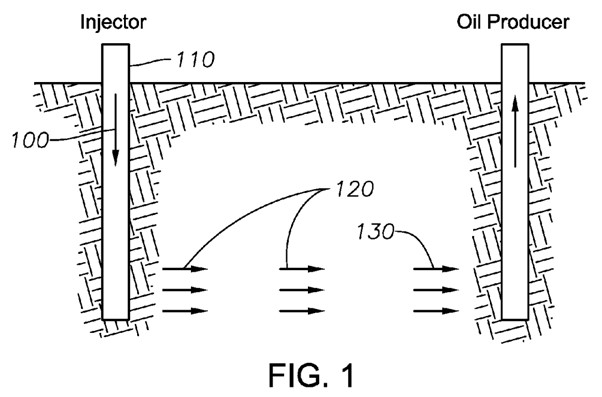
Image from: US10494566B2
100 – injection of composition; 110 – injection of activator; 120 - reaction; 130 - improvement of oil mobility.
Environmental balance and protection, Low efficiency of primary production
Patent US11001747B2 by Dow Global Technologies, LLC (US) discloses a method of recovering bitumen by contacting with a composition comprising "…(i) an alkanolamine described by the following structure: HO—R—NH2; where R is a linear alkyl group of 4 to 8 carbons with the proviso that the —NH2 group and/or —OH group are independently attached to a primary or a secondary carbon and (ii) an ethylene oxide capped glycol ether described by the following structure: R1—(C2H4O)nH; wherein R1 is a linear, branched, cyclic alkyl, phenyl, or alkyl phenyl group of equal to or greater than 4 carbons and n is 1 to 3". The composition can be used both for oil sands recovered by surface mining and for in situ production. According to the claims of the invention, the composition can be mixed with steam or water.
Among the drawbacks of prior-art solutions the authors of the invention mention safety hazards and environmental problems, use of large amount of water and energy, and other cost-related issues.
The patent is a part of a family comprising 6 patent documents published in WO, CA, US, EA, and CN in 2019-2021.
Image from: US11001747B2
Patent application US20200224085A1 filed by Fluid Energy Group Ltd (CA) discloses an aqueous synthetic acid composition for enhanced oil recovery technologies involving steam stimulation, such as steam injection, steam assisted gravity drainage, and others. The composition comprises "…lysine and hydrogen chloride in a molar ratio ranging from 1:6 to 1:12.5", a metal iodide or iodate (cuprous iodide, potassium iodide, sodium iodide, lithium iodide, or their combinations), an alcohol or its derivative (such as alkynyl alcohol, propargyl alcohol). The claims of the invention specify preferred molar ratios of the lysine and hydrogen chloride, and preferred concentrations of alcohol in the acid composition. According to the claims, the composition is used to "…suspend iron particles at a high spent pH without precipitation of said iron particles.", and "to suspend solubilized calcium carbonate at a high spent pH (4 to 6) without precipitation".
As the problems the invention targets, the authors mention human and environmental exposure, toxicity levels, biodegradation tendencies, and others.
The application belongs to a patent family comprising 14 patent documents published in CA, US, BR, CO, EP, ZA, AU, MX, and WO in 2018-2020.
Image from: US20200224085A1
SAGD, Low efficiency of primary production
Patent US10767104B2 "Compositions for enhanced oil recovery" issued to Ecolab USA Inc. (US) describes a method of enhanced oil recovery involving a special emulsion. The emulsion comprises coupling agents, "…water soluble or dispersible nonionic surfactants having an HLB greater than about 10", zwitterionic surfactants, anionic surfactants, and water. The emulsion may also contain such additives as "…viscosifying agents, solvents, alkali, non-emulsifiers, corrosion inhibitors, biocides, friction reducers, emulsion breakers, and proppants". The claims of the invention also describe a method for injecting the emulsion into a subterranean formation.
The authors of the invention specifically mention that the proposed emulsion can be used in SAGD processes to affect wettability and surface tension, which is aimed at improving the yield of hydrocarbons.
The invention belongs to a patent family consisting of 12 patent documents published in WO, AU, CA, US, EP, BR, and RU between 2016 and 2020.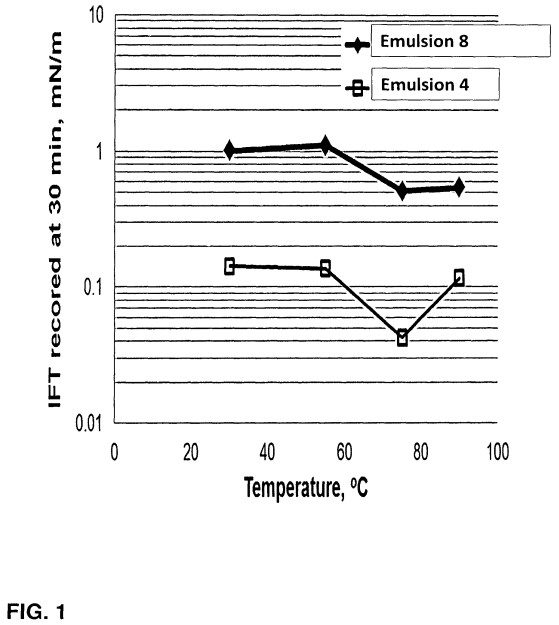
Image from: US10767104B2
Patent application US20180223179A1 by Erebos Energy Pty Ltd (AU) discloses a composition for reducing the viscosity of oil to be used with steam in steam-assisted gravity drainage technology. The composition comprises a mixture of terpene ("…limonene, α-pinene, β-pinene, camphene, menthene, turpentine, myrcene, β-caryophyllene, and α-humulene, geraniol, terpineol, myrcene, limonene, pinene, turpentine") and petroleum distillate ("…C11 to C14 aliphatic hydrocarbons selected from n-alkanes, isoalkanes and cyclic aliphatics and less than 5% w/w aromatics"). The composition further comprises "…less than 0.02% w/w of compounds comprising heteroatoms such as sulfur, phosphorus, oxygen and nitrogen". According to the claims, a flash point of the composition is in the range of 95°C-125°C. Exemplary composition comprises limonene and C11 to C14 petroleum distillate in a volume ratio of 20:80-50:50.
The invention is aimed at preventing fouling of oil flow lines and other equipment by using a safer and less hazardous material.
The patent application is a part of a family comprising 9 documents published in 2016-2018 in the WO, AU, CN, EP, MX, US, BR, and CA patent offices.
Image from: US20180223179A1
More detailed information about inventions in the field of steam-assisted production of unconventional oil, and patent research methodology can be found on aenert.com and in UNCONVETIONAL OIL PRODUCTION. Steam Injection. Extended patent report. July 2022.
By the Editorial Board
